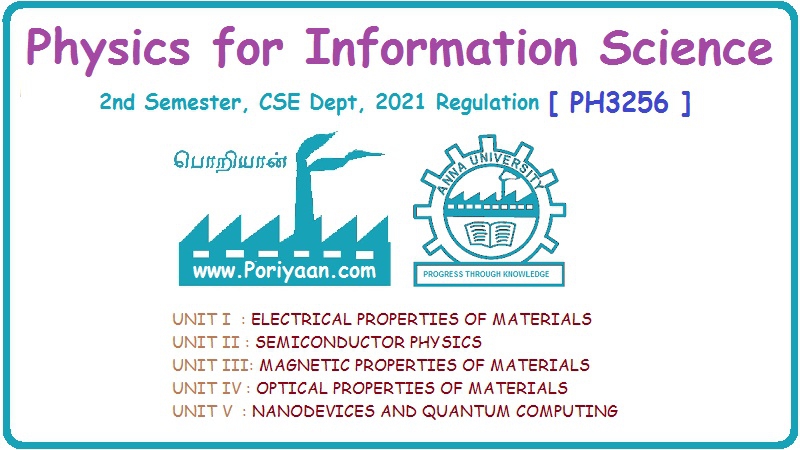Physics for Information Science: Unit II: Semiconductor Physics
Drift and Diffusion Transport
Semiconductor
The net current flow in a semiconductor is due to two types of transport, viz. Drift transport, Diffusion transport
DRIFT
AND DIFFUSION TRANSPORT
The
net current flow in a semiconductor is due to two types of transport, viz.
1.
Drift transport
2.
Diffusion transport
1. Drift transport
In
general, the movement of a charge carrier will be like a wave model rather than
a particle model in a defect free crystal. i.e., the electrons move freely in a
defect free crystal.
However,
in the absence of external electric field the random motion of charge carriers
will not contribute current, because, the charge movement in one direction will
be balanced by the charge movement in the other direction.
Now,
when the external field is applied, then the electrons are attracted to the
positive terminal and the holes are attracted to the negative terminal. This
net movement of charge carriers are termed as drift transport.
Here,
it should be noted that the drift transport overcomes the thermal movement and
result in the current flow through the material.
The
current density due to electron drift is
Je
= ne evd …..(1)
Since
drift velocity vd ∞ E (Field applied)
Vd=μe
E ……(2)
Substituting
eqn (2) in eqn (1) we can write
Je
= nee μe E ……(3)
Similarly,
The
current density due to hole drift is
Jh=nhe
μhE …...(4)
Total
drift current is J=Je+Jh …..(5)
Substituting
equations (3) and (4) in equation (5) we get
J
= nee μe E + nhe μhE
[or]
J = [nee μe + nhe μh] E ……(6)
We
know J = σ E ……(7)
Comparing
equations (6) and (7) we can write the σ = neeμe+ nhe
μh
For
intrinsic semiconductors ne= nh= ni
σi = ni e [μe
+ μh] ……(8)
2. Diffusion transport
We
know, while doping excess charge carriers are introduced in the material, which
may cause non-uniform distribution of charge carriers at some places.
Now,
when electric field is applied to the semiconductor, in addition to the drift
motion, the charge carrier also move by diffusion at the places where we have
non-uniform concentration of charge carrier in the material.
The
charge carriers move from the region of higher density to lower density, in
order to attain uniform distribution. This transport phenomena is called as
diffusion transport.
Thus
we can say that the concentration of charge carrier (Δne) varies
with distance (x) in a semiconductor.
i.e.,
The Rate of flow of charge carriers is ∞ ∂/∂x(Δne)
The
negative sign indicates that the movement of charge carries is in the direction
of negative gradient.
Rate of flow of electrons
Rate
of flow of electrons = -De∂/∂x(Δne)
Where
De→ electron diffusion coefficient
Current density due to electrons
We
know Current density Je = Charge of electron × Rate of flow of electrons
Je
= [-e] [-De ∂/∂x
(Δne)]
(or)
Je = e De ∂/∂x
(Δne) ….(9)
Similarly,
we can write
Rate of flow of holes
Rate
of flow of holes = -Dh∂/∂x(Δnh)
Where
Dh→ hole diffusion co-efficient.
Current density due to holes
We
know Current density due to holes, Jh = Charge of hole × Rate of flow of holes
Jh
= [+e] [-Dh∂/∂x(Δnh)]
Jh
= [-eDh∂/∂x(Δnh)] .....(10)
Drift and diffusion current
Thus,
if an electric field is applied to the semiconductor, the total current
contribution is due to both drift and diffusion transport.
Total current due to electrons
The
total current density due to electrons can be written as
Je
(Total) = Je (drift) + Je (diffusion)
Substituting
equations (3) and (9) in the above equation, we get
………(11)
Total
current due to holes
Similarly
the total current density due to holes can be written as
Jh(Total)
= Jh (drift) + Jh (diffusion)
Substituting
equations (4) and (10) in the above equation, we get
………(12)
J(Total)
= Je (Total) + Jh (Total)
Net
current due to both electrons and holes
The
Net current due to both electrons and holes can be obtained by adding equations
(11) and (12), as
………(13)
The
above equation (13) represents the total current density due of drift and
diffusion of electrons and holes in semiconductors.
Physics for Information Science: Unit II: Semiconductor Physics : Tag: : Semiconductor - Drift and Diffusion Transport
Related Topics
Related Subjects
Physics for Information Science
PH3256 2nd Semester CSE Dept | 2021 Regulation | 2nd Semester CSE Dept 2021 Regulation
